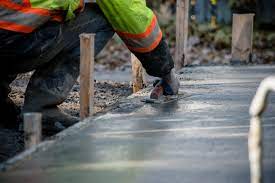How to Prevent Common Issues in Concrete Slab Construction
Concrete slabs are an important component of many construction projects because they provide a stable and long-lasting foundation for structures such as buildings, roads, and pavements. Nonetheless, despite their dependability, concrete slabs may encounter a variety of issues during construction that may jeopardize their integrity and longevity. To ensure the success of your concrete slab project, you must be aware of these potential issues and take proactive steps to avoid them. In this blog, we will discuss common issues in concrete slab construction and offer valuable prevention tips.
1. Poor Subgrade Compaction
The subgrade, or the natural soil or prepared base on which the concrete slab will be installed, is critical to the slab’s stability and performance. Poor subgrade compaction can cause the finished slab to settle, crack, and be uneven. To avoid this problem:
- Perform Proper Soil Compaction: Before placing concrete, ensure that the subgrade is adequately compacted and graded. Use appropriate compaction equipment and adhere to recommended compaction procedures.
- Inspect Subgrade Conditions: Examine the moisture content of the subgrade to ensure it is neither too dry nor too wet. Moisture management is critical for preventing soil expansion or shrinkage.
2. Insufficient Reinforcement
Reinforcement is critical for crack control and improving the structural integrity of the concrete slab. Excessive cracking and reduced load-bearing capacity are two common problems caused by inadequate reinforcement. To avoid this problem:
- Design for Appropriate Reinforcement: Work with a structural engineer to determine the proper type, size, and placement of reinforcement, such as rebar or wire mesh, based on the specific requirements of your project.
- Follow Reinforcement Placement Guidelines: Ensure that the reinforcement is properly placed within the concrete slab at the specified depth and spacing. During concrete placement, use chairs or supports to keep the reinforcement in place.
3. Inadequate Curing
Concrete requires proper curing to achieve the desired strength and durability. Inadequate curing can lead to reduced concrete strength, surface cracking, and resistance to environmental factors. To avoid this problem:
- Implement a Curing Plan: Depending on the project’s requirements and environmental conditions, create a comprehensive curing plan that includes methods such as wet curing, curing compounds, or curing blankets.
- Curing Timelines: Stick to the recommended curing times to ensure that the concrete reaches its design strength before exposing it to heavy loads or harsh weather.
4. Construction Overburdening
Excessive loads or the use of heavy equipment on freshly poured concrete can cause surface damage, cracking, and structural integrity to be compromised. To avoid this problem:
- Limit Traffic on Freshly Poured Concrete: Create clear access routes and traffic patterns to reduce heavy equipment and worker movement on the freshly poured slab.
- Use Appropriate Load Distribution: If heavy equipment is required to cross the slab, distribute the load using plywood or steel plates to reduce concentrated pressure on specific areas.
5. Inadequate Joint Positioning
Controlled joints are required in concrete slabs to accommodate shrinkage, temperature fluctuations, and movement. If proper joints are not provided, random cracking and slab damage can occur. To avoid this problem:
- Plan Joint Layout: Consult with an engineer to determine the proper spacing, depth, and type of joints for your project. Ensure that the joint placement adheres to industry standards.
- Install Joint Filler and Sealant: Use appropriate joint filler and sealant materials after joint placement to protect the joints from debris and moisture infiltration.
6. Finishing Too Soon
Finishing the concrete surface too soon can trap excess moisture, weaken it, and cause surface defects. To avoid this problem:
- Wait for the Right Time to Finish: Avoid premature finishing by waiting until the bleed water has evaporated and the concrete has set to the proper consistency before using finishing tools.
- Texture and Finish the Concrete Surface Properly: Use the appropriate finishing tools to achieve the desired texture and finish. Overworking the concrete can result in surface defects.
7. Poor Control Over Temperature and Weather Conditions
Extreme temperatures and bad weather can have a big impact on the curing and quality of concrete slabs. To avoid this problem:
- Monitor Weather Conditions: Keep an eye on weather forecasts and be prepared to protect the concrete from extreme heat, cold, rain, or frost with appropriate measures such as covers or windbreaks.
- Adjust Concrete Mix: For improved performance, consider using specialized concrete mixes designed to withstand specific temperature and weather conditions.
8. Failure to Perform Proper Surface Preparation
Failure to properly prepare the base or subgrade, including the removal of debris, contaminants, and loose materials, can lead to poor adhesion and bonding between the concrete and the base. To avoid this problem:
- Clean and Prepare the Surface Thoroughly: To promote proper bonding between the concrete and the underlying material, ensure that the base or subgrade is clean, free of debris, and properly prepared.
9. Incorrect Mix Proportions
Inadequate proportions of concrete ingredients such as water, aggregates, cement, and admixtures can result in weak and porous concrete with poor durability. To avoid this problem:
- Use High-Quality Materials: Purchase high-quality materials from reputable vendors and adhere to the recommended mix design provided by engineers or concrete experts.
- Follow Mixing Guidelines: To achieve the desired concrete consistency and strength, follow established mixing procedures, including proper water-cement ratios.
10. Ignoring Quality Control and Testing
Inadequate quality control and testing during construction can result in the use of substandard materials or improper construction practices, resulting in defects and poor performance. To avoid this problem:
- Implement Quality Control Protocols: Establish stringent quality control procedures to monitor material quality, construction practices, and concrete placement, including regular inspections and testing.
- Conduct Compression Tests: Compression tests should be performed on concrete samples to ensure that the concrete has reached the required strength before subjecting it to service loads.
11. Poor Craftsmanship
Inadequate workmanship can lead to a variety of problems, ranging from uneven surfaces to insufficient concrete mix consolidation. To avoid this problem:
- Employ Experienced and Trained Concrete Contractors and Workers: Hire experienced and trained concrete contractors and workers such as https://www.kingdomcomeconcrete.com/ who understand proper construction techniques and finishing practices.
- Ensure Adequate Training: Ensure that workers have received adequate training in concrete placement, consolidation, finishing, and curing procedures.
12. Surface Protection for Skipping
Inadequate surface protection, such as curing compounds or sealers, can expose the concrete to damage from moisture, chemicals, and abrasion. To avoid this problem:
- Surface Protection: Apply the appropriate curing compound or sealer immediately after finishing to protect the concrete surface from premature moisture loss and other environmental factors.
Conclusion
Concrete slab construction success is dependent on careful planning, meticulous execution, and a commitment to quality. You can ensure the durability, stability, and longevity of your concrete slabs by understanding the common issues that can arise during concrete slab construction and implementing preventative measures. Working with experienced professionals, adhering to industry best practices, and performing thorough quality control checks are all necessary steps to avoiding problems and ensuring the success of your concrete slab projects, learn more here.







